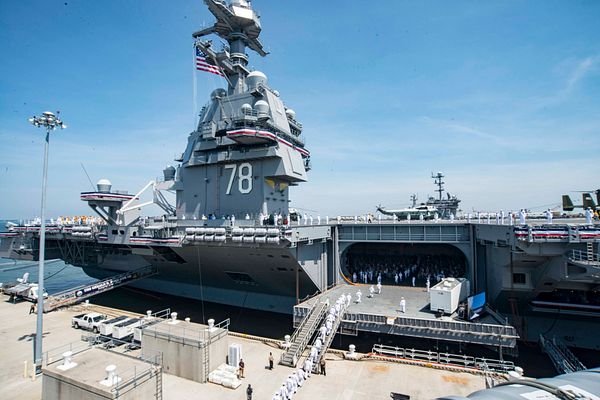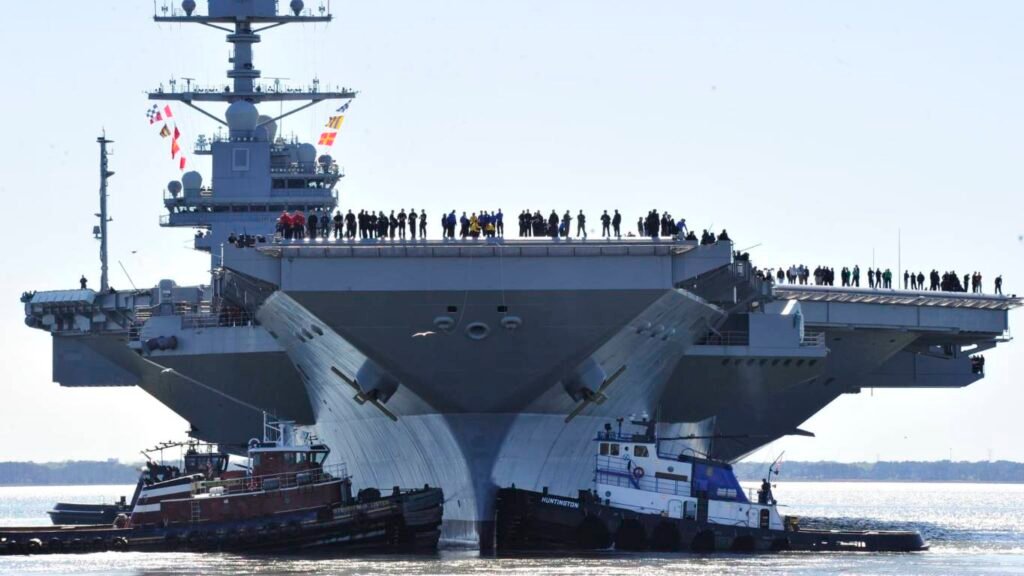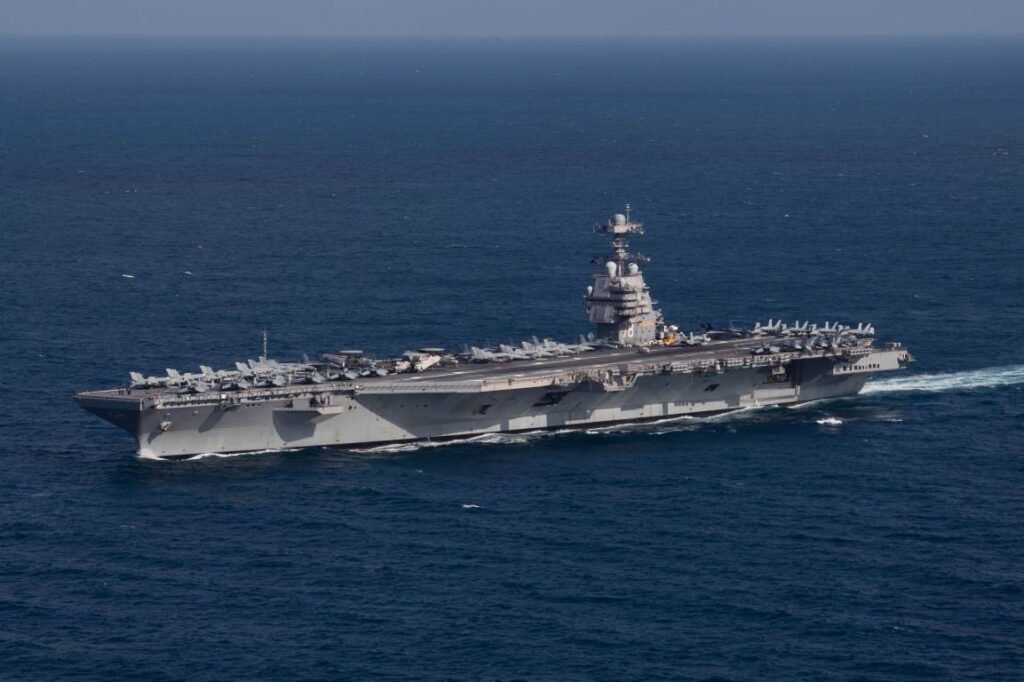The USS Gerald R. Ford is a nuclear-powered aircraft carrier of the United States Navy. It is the lead ship of its class and is named after the 38th President of the United States, Gerald R. Ford.
The USS Gerald R. Ford was built by Newport News Shipbuilding, a division of Huntington Ingalls Industries, and was commissioned into service in July 2017. It is the largest and most technologically advanced aircraft carrier ever built, with a displacement of over 100,000 tons and a length of 1,106 feet.
Some of the advanced features of the USS Gerald R. Ford include:
- Electromagnetic Aircraft Launch System (EMALS): This system replaces the traditional steam catapults used to launch aircraft from the carrier. It uses electromagnetic fields to propel planes off the deck, resulting in smoother launches and less wear and tear on aircraft.
- Advanced Arresting Gear (AAG): This system replaces the traditional hydraulic arresting cables used to recover aircraft landing on the carrier. It uses advanced technology to provide more precise and gentle deceleration of aircraft, reducing wear and tear on both the aircraft and the carrier.
- Advanced Radar System: The USS Gerald R. Ford is equipped with a new radar system that provides better detection and tracking of aircraft and other targets, as well as improved communication and coordination with other ships and aircraft.
- Increased Automation: The USS Gerald R. Ford has significantly more automation than previous aircraft carriers, which reduces the crew size required to operate the ship and allows for more efficient operation.
Also Read Why Are Warships So Expensive & Facts about Warships?
Overall, the USS Gerald R. Ford represents a significant leap forward in aircraft carrier technology and capabilities, and is expected to remain in service for decades to come.

1. Cost of USS Gerald R. Ford
The cost of the USS Gerald R. Ford was approximately $13 billion, which makes it the most expensive warship ever built. However, it is important to note that this cost includes not only the construction of the ship itself, but also the development and testing of new technologies, as well as outfitting the ship with weapons systems, aircraft, and other equipment.
The cost of the USS Gerald R. Ford has been a topic of debate and criticism, with some questioning whether the advanced technologies and features included in the ship justify its high price tag. However, supporters of the ship argue that the investments in new technologies and increased automation will lead to long-term cost savings and improved operational capabilities.
Despite the controversy over its cost, the USS Gerald R. Ford remains a critical asset to the United States Navy, providing a powerful and versatile platform for air operations and power projection around the world.
Also read https://www.cnbc.com/2017/07/22/ford-carrier-emblematic-of-navys-struggle-with-technology-costs.html
2. Size & Dimensions of USS Gerald R. Ford
The USS Gerald R. Ford is the lead ship of the Gerald R. Ford class of aircraft carriers and is the largest aircraft carrier ever built by the United States. The ship has a displacement of approximately 100,000 long tons and is 1,106 feet (337 meters) long, making it slightly longer than the previous Nimitz-class aircraft carriers.

In addition to its length, the USS Gerald R. Ford has a beam (width) of 134 feet (41 meters) and a draft (depth in the water) of 39 feet (12 meters). The ship has a height of 250 feet (76 meters) from the keel to the top of its island, which is the command center and flight control tower.
The USS Gerald R. Ford also has a flight deck that is 1,092 feet (333 meters) long and 256 feet (78 meters) wide, providing ample space for launching and recovering aircraft. The ship can accommodate up to 90 aircraft, including a mix of fixed-wing aircraft and helicopters.
Overall, the USS Gerald R. Ford is an impressive and massive vessel, with dimensions that make it well-suited for its role as a premier aircraft carrier for the United States Navy.
3. Speed & Propulsion – USS Gerald R. Ford
The USS Gerald R. Ford is powered by two nuclear reactors that generate steam to power its four propeller shafts, which drive the ship through the water. While the exact top speed of the ship is classified, it is estimated to be in excess of 30 knots (35 miles per hour or 56 kilometers per hour).
The ship’s speed is a critical factor in its operational capabilities, as it allows it to quickly travel to different areas of the world and to keep up with other ships in a battle group. The USS Gerald R. Ford is also designed to be highly maneuverable, with advanced propulsion and steering systems that allow it to quickly change course and direction.
It’s worth noting that while the USS Gerald R. Ford is an impressive and powerful warship, its primary role is to serve as a mobile airbase for a variety of aircraft, including fighter jets, surveillance planes, and helicopters. As such, its speed and maneuverability are important factors in allowing it to maintain the operational flexibility needed to support a wide range of missions and operations.

4. Number of Aircraft she can carry
The USS Gerald R. Ford is designed to carry a mix of aircraft, including fixed-wing fighter jets, surveillance planes, and helicopters. The ship has a total deck area of 4.5 acres (18,210 square meters) and can accommodate up to 90 aircraft, although the exact mix of aircraft carried will depend on the specific mission and operational requirements.
The ship features a large flight deck that is 1,092 feet (333 meters) long and 256 feet (78 meters) wide, providing ample space for launching and recovering aircraft. The flight deck is equipped with a variety of aircraft handling and support equipment, including catapults and arresting gear to launch and recover aircraft.
In addition to its aircraft capacity, the USS Gerald R. Ford is also equipped with a variety of advanced technologies and systems to support its air operations, including an advanced aircraft handling system, radar systems, and communication equipment. These systems allow the ship to effectively coordinate and control its air operations, providing a powerful and versatile platform for air support and power projection around the world.
Must Read Why Do Ships Have A Bulbous Bow – Advantages & Disadvantages
5. Its Unique Propellers
USS Gerald Ford is fitted with Four Propellers, and each of them weighs 30 tons. They are each 21 feet or 6.4 meters in diameter and are made up of Bronze.
The USS Gerald R. Ford features a unique propeller design that sets it apart from previous aircraft carrier classes. The ship’s propellers are made of composite materials rather than traditional metal alloys, which makes them lighter and more durable.
The propellers are also larger than those on previous aircraft carriers, with a diameter of 30 feet (9.1 meters) each, and are driven by advanced electric motors rather than traditional hydraulic systems. The electric motors are more efficient and provide better control over the ship’s propulsion, allowing it to operate more quietly and with greater precision.
The propellers on the USS Gerald R. Ford are also designed to be highly resistant to damage from underwater explosions, which is a critical factor in protecting the ship and its crew from potential threats. The composite materials used in the propellers are highly resistant to fatigue and corrosion, and can withstand the extreme pressures and stresses of high-speed operation.
6. Starbucks onboard USS Gerald Ford
USS Gerald R. Ford actually has its own shops and even offers Starbucks Coffee onboard. The coffee shop is not for profits and all proceeds go to support various schemes for the ship’s crew.
7. Operating Cost
In comparison to the Nimitz-class, each Gerald Ford class ship will save more than $4 billion in total ownership expenditures over its 50-year service life.
The exact operating cost of the USS Gerald R. Ford is not publicly disclosed by the U.S. Navy, as it includes a wide range of factors and expenses, such as maintenance, repairs, fuel, and personnel costs. However, it is widely known that operating a large and complex warship like the USS Gerald R. Ford is an expensive endeavor, and that the cost per day can range in the millions of dollars.
Some estimates suggest that the cost of operating the USS Gerald R. Ford could be as high as $2.3 million per day, which includes the cost of the ship’s nuclear reactors, advanced propulsion systems, and sophisticated electronics and communication equipment. However, the actual cost will depend on a variety of factors, including the ship’s mission, operational requirements, and the specific tasks it is assigned to perform.
Despite its high operating costs, the USS Gerald R. Ford is a critical component of the U.S. Navy’s overall military capabilities, providing a versatile and powerful platform for a wide range of missions and operations around the world. The ship’s advanced technology and capabilities are designed to ensure that it can operate effectively in a wide range of environments and situations, from combat operations to humanitarian assistance and disaster relief efforts.

8. Quantity of Paint
A total of 200,000 gallons (757,082 liters) of paint was used to cover the entire exterior hull of the ship. Apparently, this is enough to coat the exterior of the White House 350 times over.
9. Design of its Toilet
The USS Gerald Ford can carry about 5,000 crews is the first new US aircraft carrier designed in last 40 years, and in line with the reality that US Navy has about 20% female sailors, USS Gerald R Ford has gender-neutral toilets, which is quite a deviation from the normal urinals on other aircraft carriers of the US Navy.
10. Name Inspired by 38th President of the United States
Namesake: The USS Gerald R. Ford is named after the 38th President of the United States, who served from 1974 to 1977. President Ford served in the U.S. Navy during World War II and was awarded the Navy Cross for his bravery in combat.

